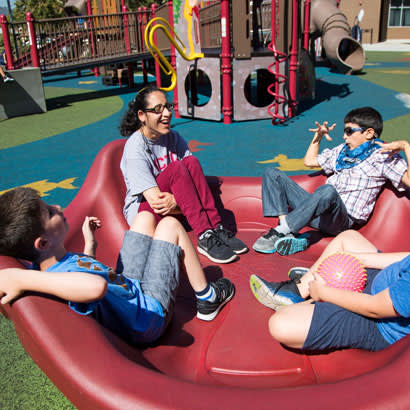
When people pass by a community park sprouting colorful, inviting play structures, they might recall the fun, carefree days of childhood and smile.
Park and recreation professionals go beyond just those memories.
Their thoughts also go to the accessibility of quality play spaces, the safety of the equipment or the necessary investment to provide physical, social and emotional development to children and families in their community. And you can be sure they crack a smile when they see that kids of all ages, abilities and backgrounds are enjoying time on the community’s playgrounds.
That’s the goal for all children: the chance to play freely. And a childhood that includes the full spectrum of developmental opportunities.
Returning to the playground
While children slowly, safely resume outdoor play during the coronavirus pandemic, each child will experience the playground in their own way. That’s why it’s important for park professionals to remember that for kids with special needs, regulating their bodies and emotions through play and socialization may be even more critical.
“Playgrounds can be an ideal natural play setting for children who are neurotypical,” said Virginia Spielmann, executive director at the STAR Institute for Sensory Processing Disorder. “But for kids with special needs, a traditional playground doesn’t offer the same opportunities to master physical challenges, gain social confidence or hone fine motor skills.”
Many experience sensory challenges
Thanks in part to advances in brain imaging technologies, such as structural and functional MRIs, we are beginning to learn just how — and how many — children feel, process and respond to everyday sensory events more vividly or differently than most.
According to breakthrough research by the University of California San Francisco, 5 to 16 percent of school-aged children experience sensory processing difficulties. Some have biological differences in brain structure and connectivity patterns that cause them to take in and respond to stimuli differently than most.
How does this affect a child’s experience on the playground? It differs with each child, of course, but the struggle to take in, integrate and process sensory stimulation — whether it’s the chaotic spin of a whirling merry-go-round or the noise and tussle of rambunctious climbers on monkey bars — can sometimes prove overwhelming.
To highly sensitive children, these intense experiences can feel like an assault on their senses. In other cases, children may seek out external stimulation.
“Children who struggle to process external stimuli can react in many different ways to visual input, sounds, smells, balance, movement and more,” explains Spielmann. They may react strongly and with enthusiasm, or they may be overwhelmed and retreat. And often, they can’t match the motor skills of other children, which adds to feelings of being different and isolated — especially on a traditional playground.”
Playgrounds have evolved
The right play equipment can make all the difference. And today’s thoughtfully designed playgrounds have evolved into places that foster all-sensory experiences for every child.
Inclusive playgrounds are among the few places where a child with special needs can feel like just another kid who wants to have fun. Here, kids who live with the stigma of being “other” or “less than” can choose their own level of activity, create their own play experience and finally find new ways to connect with others.
The hallmark of an inclusive playground? Intentional design.
Intentionally inclusive design insights
When playground equipment planners and designers are educated and interested in how kids with special needs experience the world, it informs their approach and designs — and makes an enormous difference in the final product.
That insight can translate to subtle equipment details in materials, shapes, movement or orientation. For example, a play structure with built-in tactile elements invites children to explore a variety of textures and shapes and helps them to integrate multiple tactile experiences.
Some play structures also offer a variety of interactive panels in a variety of positions — including passive musical or auditory components. These inclusive playgrounds also incorporate quiet, cozy spaces where overstimulated kids can go for a calming escape to regain their equilibrium and recharge.
And there are many other ways that playground design can invite children of all abilities to play, explore and learn with confidence, to connect with others on their own terms and to feel a sense of control over their surroundings.
Park and recreation professionals know that what looks like mere child’s play is really vital preparation for life. And it is owed to all kids in our communities to prepare them for their best possible life.
Lynn Pinoniemi is the vice president of marketing for Landscape Structures Inc.

